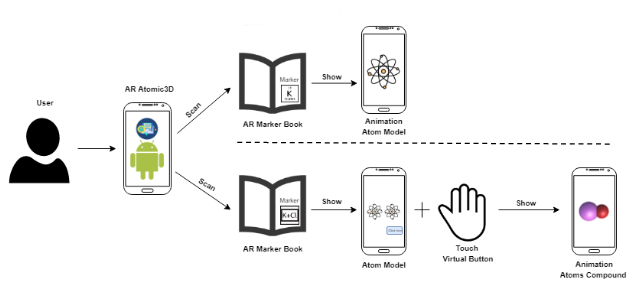The Development of Augmented Reality Technology Applications for Learning about Elements and Chemical Compounds
Main Article Content
Abstract
In this research, the researchers propose using Augmented Reality (AR) technology to develop the atom of learning applications and the integration of atoms of chemical elements into compunds. The application promotes chemistry teaching to be more interesting. Students can understand more quickly and encourage learners to be effective. The creation of this AR technology application combines the atomic model of forty-four primary chemical elements and the integration of atoms into five molecules to create 3D animation. It is used application combine with the atomic data book and the combination of atom elements into a compound; the user needs to use it with a smartphone to scan at the booklet. The examinations of this research were evaluated with 33 students in grad 10 in Ban Klang Pittayakhom School. The results of the study showed that satisfaction with the content and content operations was the highest level ( = 4.3, S.D. = 0.66). Statisfation with models, animation, and sound, which results was the highest level (
= 4.22, S.D. = 0.70). Satisfaction with the use results was the highest level (
= 4.18, S.D. = 0.82). The satisfaction with the assessment of knowledge and benefits was at the highest level (
= 4.34, S.D. = 0.64). Moreover, the results of the post-test scores were greater than the pre-test scores. It can be concluded that this educational application has a considerable effeect on the development of learning about elements and chemical compounds for students.
Article Details

This work is licensed under a Creative Commons Attribution-NonCommercial-NoDerivatives 4.0 International License.
All authors need to complete copyright transfer to Journal of Applied Informatics and Technology prior to publication. For more details click this link: https://ph01.tci-thaijo.org/index.php/jait/copyrightlicense
References
กระทรวงศึกษาธิการ. (2560). หลักสูตรแกนกลางการศึกษาขั้นพื้นฐาน พุทธศักราช 2551 (ฉบับปรับปรุง2560). สืบค้น 25 มกราคม 2562, สืบค้นจาก https://drive.google.com/file/d/0B9t56k6dmUe5SDJ0MWFmNGt3dFE/view
จอมใจ สุกใส. ธาตุเรพรีเซนเททีฟ (Representative Elements). พิมพ์ครั้งที่ 1. กรุงเทพฯ : แดเน็กซ์อินเตอร์คอร์ปอเรชั่น, 2559.
ณปภัชร รู้สมกาย. (2560). แบบจำลองอะตอม. สืบค้น 25 มกราคม 2562, สืบค้นจาก https://www.scimath.org/lesson-chemistry/item/7437-2017-08-11-04-28-08
ณปภัช พิมพ์ดี. (2560). ธาตุและสารประกอบ. สืบค้น 25 มกราคม 2562, สืบค้นจาก https://www.scimath.org/lesson-chemistry/item/7175-2017-06-05-13-51-33
ณปภัช พิมพ์ดี. (2560). รูปร่างโมเลกุล. สืบค้น 25 มกราคม 2562, สืบค้นจาก https://www.scimath.org/lesson-chemistry/item/7130-2017-06-04-07-54-56
ณัฏฐ์ ดิษเจริญ. (2557). การพัฒนาสื่อการเรียนรู้เรื่อง โครงสร้างอะตอมและพันธะเคมีด้วยเทคโนโลยีออกเต็ดเรียลลิตี้. วารสารหน่วยวิจัยวิทยาศาสตร์ เทคโนโลยี และสิ่งแวดล้อมเพื่อการเรียนรู้, 5(1), 21-27.
อภิชาติ อนุกูลเวช. (2557). Augmented Reality (AR). สืบค้น 25 มกราคม 2562, สืบค้นจาก http://abhichatdotcom.blogspot.com/2014/12/augmented-reality-ar.html
ตัน รูเซนดอล. (2011). Blender. สืบค้น 25 มกราคม 2562, สืบค้นจาก https://www.blender.org/about/
นวัตกรรมและเทคโนโลยีสารสนเทศ. (2555). ปัญหาจากครูผู้สอนและผู้เรียน. สืบค้น 25 มกราคม 2562, สืบค้นจาก http://mediathailand-ictedu.blogspot.com/2012/07/124.html
บุญเกื้อ ควรหาเวช. (2543). คอมพิวเตอร์ช่วยสอน(Computer Assisted Instruction). สืบค้น 25 มกราคม 2562, สืบค้นจาก http://senarak.tripod.com/cai2.htm
ประจวบ ปวรางกูร. (2557). การนำเทคโนโลยีเสมือนจริงมาประยุกต์ใช้กับการเรียนการสอน. สืบค้น 25 มกราคม 2562, สืบค้นจาก http://www.mut.ac.th/research-detail-19
สุรพล บุญลือ. (2555). แนวคิดหลักของ Augmented Reality. สืบค้น 16 มกราคม 2561, สืบค้นจาก https://www.slideshare.net/fantameet/augmented-reality-12726680
พนิดา ตันศิริ. (2555). ระบบเสมือนเสริมบนโทรศัพท์มือถือ. วารสารนักบริหาร, 30(2), 169-175.
พรทิพย์ ปริยวา. (2557). ผลของการใช้บทเรียน Augmented Reality Code เรื่องคำศัพท์ภาษาจีนพื้นฐานสำหรับนักเรียนชั้นประถมศึกษาปีที่ ๓ โรงเรียนเทศบาล ๒ วัดตานีนรสโมสร. [วิทยานิพนธ์ปริญญาศึกษาศาสตรมหาบัณฑิต มหาวิทยาลัยสงขลานครินทร์]. https://kb.psu.ac.th/psukb/handle/2016/10614
พจน์ศิรินทร์ ลิมปินันทน์. (2560). เทคโนโลยีความเป็นจริงเสริมส่งเสริมความคงทนในการจำคำศัพท์ภาษาอังกฤษ. วารสารวิชาการการจัดการเทคโนโลยีสารสนเทศและนวัตกรรม, 4(2), 7-16.
สัมฤทธิ์ โม้พวง. เคมีอนินทรีย์ 1 (Inorganic Chemistry I). พิมพ์ครั้งที่ 1. พิษณุโลก : ป. งานพิมพ์, 2551.
วิวัฒน์ มีสุวรรณ์. (2555). Augmented Reality กับบริบทในทางการเรียนรู้. สืบค้น 25 มกราคม 2562, สืบค้นจาก http://wiwatmee.blogspot.com
สถาบันส่งเสริมการสอนวิทยาศาสตร์และเทคโนโลยี (สสวท.). (2556). สื่อเสริมการเรียนรู้ โลกเสมือนผสมโลกจริง (Augmented Reality) เรื่องการจมและการลอย. สืบค้น 25 มกราคม 2562, สืบค้นจาก http://secondsci.ipst.ac.th/?p=681
สถาบันส่งเสริมการสอนวิทยาศาสตร์และเทคโนโลยี (สสวท.). หนังสือเรียนรายวิชาเพิ่มเติม เคมี เล่ม 1. พิมพ์ครั้งที่ 2. กรุงเทพฯ : โรงพิมพ์คุรุสภาลาดพร้าว, 2553.
สุรศักดิ์ ผลาผล (2561). ความรู้พื้นฐานเกี่ยวกับโปรแกรม Unity 3D. สืบค้น 19 มกราคม 2562, สืบค้นจาก https://sites.google.com/site/surasakarapplicationonmobile/
อนุสิษฐ์ เกื้อกูล. (2560). เคมีพื้นฐาน. สืบค้น 25 มกราคม 2562, สืบค้นจากhttps://www.scimath.org/lesson-chemistry/item/7122-2017-06-04-07-25-22
ไพรินทร์ มีศรี. (2558). การพัฒนาบทเรียนคอมพิวเตอร์ช่วยสอน เรื่อง การฝึกบุคคลท่ามือเปล่า. วารสารวิจัยและพัฒนา วไลยอลงกรณ์ในพระบรมราชูปถัมภ์ สาขาวิทยาศาสตร์และเทคโนโลยี, 10(1), 69-77.
สุทธิกานต์ บ่อจักรพันธ์, เกียรติภูมิ อุเหล่า, ปวรัชชา ศิริโนนรัง และ มานะ โสภา. (2559). การพัฒนาสื่อการเรียนการสอนด้วยเทคโนโลยีความจริงเสริม วิชาเคมีเรื่อง แบบจำลองอะตอม สำหรับนักเรียนชั้นมัธยมศึกษาปีที่ 4. วารสารโครงงานวิทยาการคอมพิวเตอร์และเทคโนโลยีสารสนเทศ, 2(2), 73-80.
สุพจน์ สุทาธรรม และ ณัฐพงศ์ พลสยม. (2559). การพัฒนาสื่อการเรียนรู้เรื่อง ฮาร์ดแวร์ ด้วยเทคโนโลยี Augmented Reality. วารสารวิชาการการจัดการเทคโนโลยีสารสนเทศและนวัตกรรม, 3(2), 33-38.
Unity Insight. (2559). ทำความรู้จักกับ Unity. สืบค้น 25 มกราคม 2562, สืบค้นจาก https://unityinsight.wordpress.com/2016/07/16/introduce-unity/
Yang, S., Mei, B., & Yue, X. (2018). Mobile augmented reality assisted chemical education: insights from elements 4D. Journal of Chemical Education, 95, 1060-1062.






